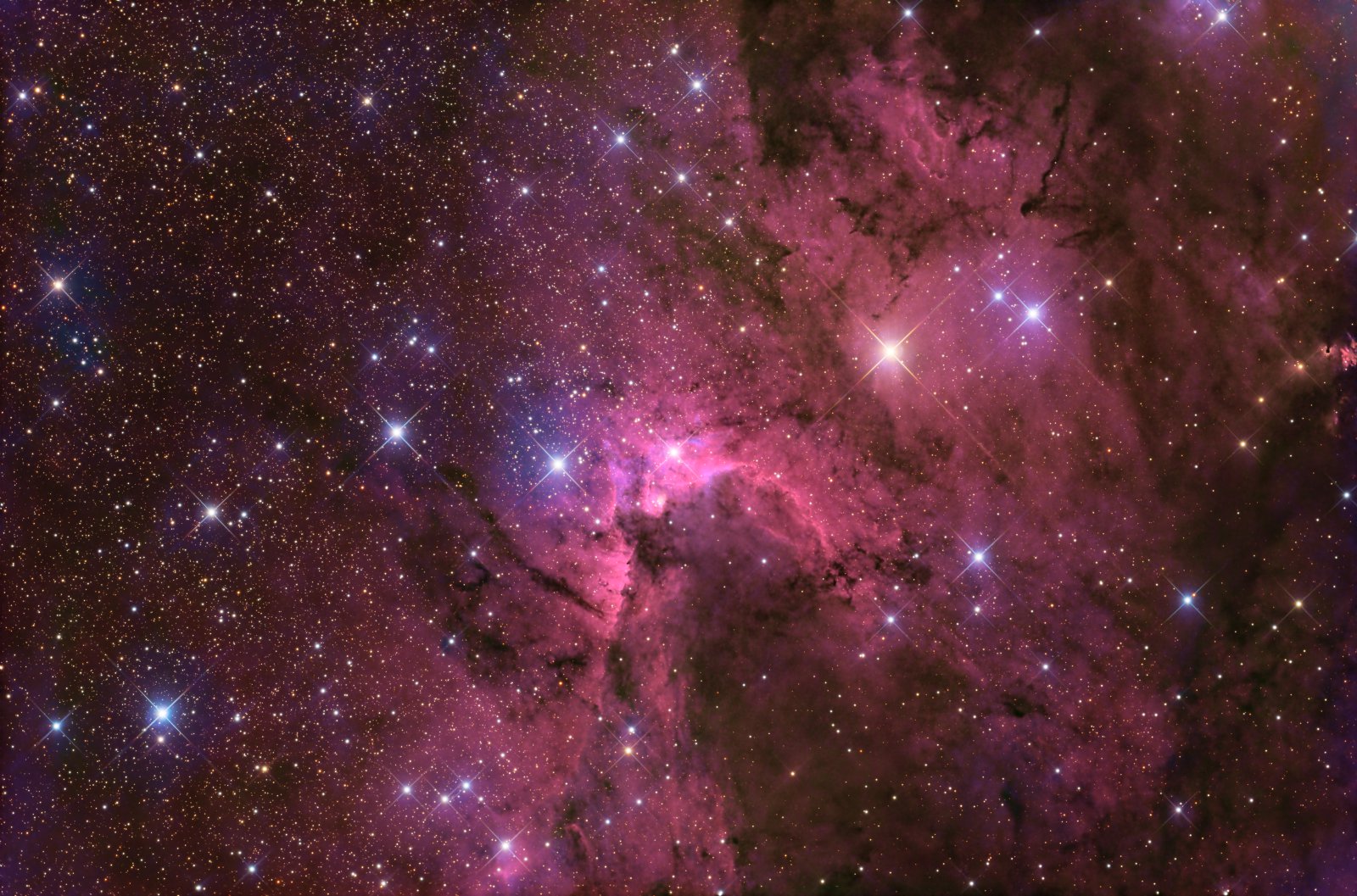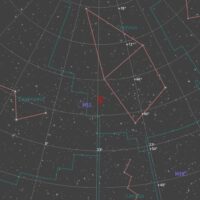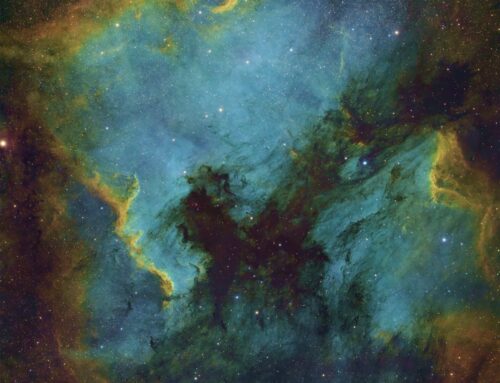Sh2-155, The Cave Nebula
 Click image for full size version
Click image for full size version
January 21, 2024
The Cave Nebula lies in the constellation Cepheus about 2,400 light years away, pretty close in cosmic terms. The “cave” has a bright rim ionized by the hot blue-white stars in the vicinity. The main “cave” structure is 10 light years across and is catalogued as Sharpless 155 (Sh2-155) and also as Caldwell 9. The Caldwell catalogue was compiled by Sir Patrick Moore, and named for his mother’s maiden name.
The Cave Nebula region makes a nice narrowband image using the Hubble palette. A previous version of this image was published in the April 2016 issue of Sky and Telescope. However, the new version shows far more depth and detail.
Tekkies:
SBIG STL-11000M camera, Baader Ha, R, G, and B filters, 10″ f/6.8 ASA Newtonian astrograph, Paramount MX. Guided with QHY5 guide camera and 80 mm f/6 Stellar-Vue refractor. Acquisition, guiding and mount control with TheSkyX. Focusing with FocusMax. Automation with CCDCommander. All preprocessing and post-processing in PixInsight. Shot from my SkyShed in Guelph, Ontario October 30 – November 9, 2015. Moderate moonlight for Ha and no moon for RGB. Good to very good transparency and seeing throughout acquisition.
28x15m Red
28x15m Green
28x15m Blue
10x30m H-alpha
Total=26hr00m
Image scale is 1.1″/pixel
Preprocessing: The WeightedBatchPreProcessing script was used to perform calibration, cosmetic correction, weighting, registration, local normalization and integration of all frames.
RGB master: A master RGB image was made from the Red, Green and Blue masters using ChannelCombination in RGB mode.
Synthetic Luminance: The four masters (R, G, B, Ha) were combined with no rejection, weighted for SNR, using ImageIntegration.
Gradient Removal: The GraXpert AI program was used to remove gradients from the RGB, SynthL, and Ha masters. It was applied in subtraction mode with no smoothing.
Colour Calibration: ColorCalibration was used to calibrate the RGB master.
Deconvolution: BlurXterminator was applied to the three masters with Automatic psf , star sharpening set to 0.4, and non-stellar set to 0.9.
Star Removal: StarXterminator was used to remove the stars from the three masters, with default settings. Only the RGB stars-only image was retained.
Linear Noise Reduction: NoiseXterminator was applied to the three masters with settings Amount=0.9 and Detail=0.35
Continuum Subtraction: The ContinuumSubtraction script was applied to the Ha master.
Stretching: HistogramTransformation was applied to the three masters to make pleasing images. Approximate background level after stretch was 0.09 for Ha and 0.10 for RGB.
Nonlinear Processing
Addition of SynthL to RGB: LRGBCombination was used to replace the L* channel of the RGB image with the SynthL.
Addition of Ha to LRGB: PixelMath was used to blend the Ha master into the LRGB image using the following expression with parameter values a=1.8 and b=0.08.
Red: max($T[0], a*Ha)
Green: $T[1]
Blue: iif($T[0]<a*Ha, $T[2] + b * Ha, $T[2])
Nonlinear Noise Reduction: NoiseXterminator was used to reduce noise in the background areas of both masters with Amount=0.9 and Detail=0.15.
Re-stretch: HistogramTransformation was used to boost contrast by moving the dark point to the toe of the histogram and slightly decreasing the mid-point slider.
Contrast Enhancement: LocalHistogramEqualization was applied three times. A Contrast Limit of 1.5 and 1 iteration was used for each LHE application (scale 40, strength 0.35; scale 100, Strength 0.3; scale 150, strength 0.35).
Sharpening: MultiscaleMedianTransform was applied. (Layers 1 – 5 with strengths of 0.01, 0.02, 0.04, 0.02, and 0.01, respectively).
Stars-only steps: HistogramTransformation was applied to the RGB stars-only image. A mask was made by using ChannelExtraction to extract the luminance from the image. CurvesTransformation was used to add saturation to the stars through the star mask, using the saturation slider.
Star Restoration: PixelMath expression combine(starless, stars, op_screen()) was used to combine the starless HaLRGB starless image with the stars-only image.
Final Steps: Background, nebula, and star brightness, contrast, hue, and saturation were adjusted in several iterations using CurvesTransformation with masks as required. ICCProfileTransformation (sRGB IEC61966-2.1; Relative Colorimetric with black point compensation) was applied prior to saving as a jpg. The finder chart was made using the FindingChart process.







Great picture Ron! Isn’t 15 minute RGB exposures longer than you usually take? In my skies in northern Michigan I can’t go past 5 minutes for GGB.
This data was acquired with a CCD camera with much lower quantum efficiency. I always used longer exposure times for that camera than I do for current CMOS cameras.